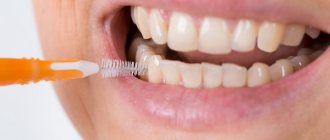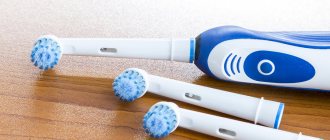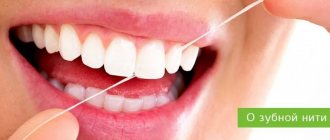Indications Advantages of use Contraindications How to use?
Dental floss and braces Types How to choose? If the floss gets stuck Brand rating For quality oral hygiene, just a brush with paste is not enough. Teeth have 5 surfaces, the brush effectively cleans 3 - anterior, lingual, chewing. The remaining 2 (cervical area, interdental spaces) need to be cleaned of plaque and food debris using additional hygiene products - dental floss or an interdental brush. And if, with dense interdental spaces, the effectiveness of a brush is in doubt, then the benefits of correctly chosen flosses are obvious. But many people don’t even know how to use dental floss correctly.
What is dental floss?
Floss is a special thread made of silk or polymer fiber for high-quality cleaning of the spaces between incisors, canines, premolars, and molars. It helps remove food particles in a similar way to a toothpick, but is much safer and more effective. The fibrous structure of dental floss makes it possible to gently and gently remove deposits from the enamel, preventing bacteria from multiplying and destroying hard tissue. The floss is placed between the teeth, cleaning first one side and then the other side of the dentition. It is important to know how to use dental floss correctly, otherwise the opposite effect will be obtained instead of benefit.
What is floss and how to use it correctly
Floss is used to cleanse the interdental space, remove food debris and plaque particles from the mouth and prevent the formation of tartar. If the brush mainly cleans the front walls of the teeth and gums, the target of dental floss is the space between the teeth where the brush cannot reach. This is an effective prevention of many diseases and reliable assistance in the fight for cleanliness.
Floss is made from silk, nylon, nylon or acetate fibers, has a special weave and special impregnation for improved glide, as well as additional treatment with a medical composition. Which material to choose is not so important, but it is better to first consult with your dentist.
This simple device performs several important tasks at once:
- normalizes the acid balance in the mouth, thereby counteracting the development of diseases and demineralization of teeth;
- prevents the formation of an unpleasant odor - effectively removes food debris and plaque, along with bacteria, no bacteria - no odor;
- prevents the formation of caries, gum disease and other oral diseases.
But floss is only effective if it is used correctly. Basic recommendations and tips on how to use dental floss correctly:
- Before the procedure, be sure to wash your hands with soap;
- for effective teeth cleaning, a piece of thread about 20-30 cm long is required;
- the ends of the segment are wound around the middle fingers of both hands;
- the thread is pulled between the index finger and thumb;
- place the stretched floss between two adjacent teeth;
- we move the floss between the teeth, moving it up or down, gradually approaching the gums, avoiding too fast or sudden movements and jerks, so as not to damage the tooth enamel or soft tissues;
- we pull it around the tooth in a semicircle (to form the letter “c”) and move it back and forth several times, 7-8 movements are enough;
- Without removing the floss from the interdental gap, we wrap the adjacent tooth in the same way and repeat the cleaning;
- We repeat the procedure with all teeth, including the distant ones - this is where, as practice shows, the most bacteria accumulate and it is the most difficult to reach during hygiene procedures, so you should spend a little more time on the outermost lateral teeth.
At first, without experience and practice, it is not easy to perform the procedure, so at first it will take quite a lot of time. But after a few days you will get used to it and will perform it automatically, easily and quickly.
Important: to clean each subsequent tooth, you should use a clean section of the floss, otherwise you will not clean the oral cavity, but will transfer dirt and bacteria from the affected area to the healthy one. The meaning of the procedure in this case is simply lost.
Under no circumstances should you replace floss with regular threads - they have a rougher surface and can damage the tissues of the oral cavity.
When to use floss
There are different recommendations for how to use dental floss. Some experts believe that it is more effective to apply it before hygienic brushing, while others believe that floss is more effective after brushing with paste. There is no general scientific basis or clinical studies on this issue. The only important thing is the systematic use of dental floss.
Direct indication for flossing:
- crowded teeth;
- installation of approximal fillings;
- periodontal diseases;
- the presence of any non-removable orthodontic (braces), orthopedic (crowns, dentures) structures.
To maintain healthy teeth and gums, hygienic cleaning should be performed 2 times, daily, morning and evening. Flossing is part of oral hygiene. This product will finish the job where you can’t reach with a brush. Dental floss is recommended for everyone, without restrictions on age or structural features of the dental system. Flossing is needed for milk teeth, permanent teeth, and artificial teeth (crowns, dentures).
What is floss used for?
Dental floss does a job that a toothbrush cannot do: cleans the spaces between teeth where plaque and food particles accumulate. This prevents the risk of gum disease and tooth decay. The manipulation itself takes only a few minutes - but before you figure out how to use dental floss, it is important to understand what types of floss there are. It is best to consult a dentist when selecting floss, as it is important to take into account the condition of the teeth, gums and oral cavity as a whole.
Dental floss is divided into 2 types according to format:
- the classic version in the form of a skein in a box, when the thread needs to be pulled out and wound around your fingers;
- flosser - when the thread is already fixed in a disposable holder; They are sold in packs of several pieces and are optimal for use on the road.
According to their shape, the threads are divided into:
- round - for healthy teeth with physiologically normal interdental spaces;
- flat - well suited for crowded teeth with reduced spaces;
- tape - with increased spaces between teeth (tremes and diastemas).
Materials from which floss is made:
- silk - threads of low strength, but very delicate, but now they are very little represented on the market;
- nylon is the most common material, optimal in terms of strength, cost and efficiency; it is very easy to find and buy;
- Teflon is the most expensive high-strength material.
When asking how to use dental floss correctly, you need to take into account one more parameter - the presence of impregnation. Impregnation is important for solving problems in the oral cavity. Flosses without impregnation are called unwaxed; they fluff well under the influence of saliva and effectively clean large areas of interdental spaces. However, they do not glide as easily as waxed ones, can injure your gums, and are generally better suited for experienced users.
Waxed threads, due to impregnation, glide very smoothly between the teeth, are suitable for beginners and, depending on the type of impregnation, have an additional effect:
- herbal extracts help maintain healthy gums;
- antibacterial substances destroy cariogenic bacteria;
- antiseptics fight inflammation and infections;
- menthol freshens breath and helps fight bad breath.
How to use: instructions
To use dental floss most effectively, you need to know the correct cleaning technology:
- Pull out a part of the floss 45-60 cm long. This length is enough to securely fix the thread on your fingers. Also, each dental unit is processed with a new part, so it is more convenient to initially take a longer floss.
- Twist the ends of the thread around your index or middle fingers. Make several turns, leaving a stretched part about 3 cm long between the thumbs. This part will be used to clean the contact surfaces.
- Gently insert the floss into the interdental space. After several light forward movements, the thread is inserted just below the gingival margin. Carefully move it up and down between the contact surfaces, around the tooth, slightly penetrating under the cervical area. Do not tug or pull the thread so as not to damage the mucous membrane and gum tissue.
- A similar procedure is repeated for all adjacent teeth. Cleaning begins with the upper row of teeth, then cleans the lower one. They move from the central incisors to the edges, in one direction or the other. To develop a habit, you should clean the segments according to the same principle each time.
- Moving on to the next tooth, move the floss using a new, clean part. To do this, move your fingers, rewinding the used segment.
- After cleaning, rinse your mouth with warm water or a special product. This will get rid of food particles, plaque residues, and provide fresh breath.
Do not make cutting movements or insert the thread deep under the gum, avoiding damage to the dentogingival attachment. When everything is done correctly, there is no discomfort or pain. After processing the dentition, the used floss is thrown away. Repeated use will provoke the spread of pathogenic microorganisms in the oral cavity, inflammation and other problems.
The first few days after flossing, your gums may bleed slightly. With regular cleaning, the bleeding stops on its own. But if during hygiene you constantly find bleeding gums, you need to go to the dentist for an examination and diagnosis.
Correct technique
Learning how to use a thread correctly will require some effort, but then you will be able to carry out this procedure without any problems. Dentists recommend taking about 40 cm of dental floss and wrapping most of it around the middle finger of one hand. Wrap the rest of the thread around the middle finger of your other hand, leaving a small section of thread free.
Pinch the floss between the thumbs and forefingers of both hands and insert it between two teeth. Gently move the floss up and down until it reaches the gum, then wrap the floss tightly around the base of one of the teeth in a C shape and gently bring it below the gum next to that tooth. Clean the subgingival area of the other tooth in the same way. To treat adjacent tooth surfaces, move the floss up and down and back and forth, pressing it firmly against the tooth.
Remove the floss from between your teeth, take the clean floss from the finger that has most of the floss wrapped around it, and tighten the floss by wrapping the used floss around the middle finger of your other hand. Clean all spaces between teeth, using a clean section of floss each time.
How to floss with braces
For braces, there are superflosses with hard tips that clean not only the contact surfaces of the enamel, but also the elements of the corrective equipment. They easily pass areas above/under the arch, around the locks. The floss is inserted over the arch into the interdental space. When the thread is in the correct position, use gentle up and down movements to clean the enamel surfaces. All other adjacent surfaces of the dental units are cleaned in a similar way. The thread is used after cleaning with a brush or brush. A special orthodontic needle threader will make threading over the wire easier.
How often can it be used?
In principle, dental floss should be used as needed, but dentists advise flossing daily before bed, or at least 2-3 times a week. It must be said that experts differ in their opinions about when to use floss - before or after brushing your teeth.
Some believe that flossing after a toothbrush promotes better oral hygiene, while others believe that it should be used before a toothbrush, since after cleaning the interdental spaces, the toothbrush will clean the teeth better. In fact, this is not fundamentally important, the main thing is that dentists unanimously say that using dental floss is useful.
Kinds
Modern threads are made from silk or polymer fibers (nylon, nylon, Teflon, acetate). Floss is sold in special cassettes (from 10 to 100 m), providing hygienic storage and comfortable unwinding of the required length, thanks to the cutting edge under the lid.
Manufacturers also offer threads on a holder (flosser, dental machine). They are sold in several units per package. Some people choose a flosser, since its use eliminates the contact of hands with the oral mucosa and makes caring for eighth molars (wisdom teeth) easier.
How to brush your teeth with a brush
The best time to clean between teeth is in the evening. Whether you do this before or after brushing your teeth doesn’t matter.
We consider Curaprox interdental brushes to be one of the best. They are very easy to use, and their manufacturer has proposed their own cleaning method - just like in the case of atraumatic flossing using the loop method.
1. Insert the brush at an angle to the gum.
2. Turn the brush perpendicular to the teeth and carefully move it into the interdental space.
3. You should feel that the brush has come out from the other side.
4. 1 gap = 1 movement of the brush. Do not rotate the brush or move it back and forth.
5. Slowly remove the brush and insert it into the next gap.
What is the difference between dental floss?
Various types of thread are available for sale. Waxed, non-waxed, impregnated with silver, menthol, medicinal herbal extracts, as indicated on the package. Flosses are distinguished by cross-section, thickness, material, and processing.
According to sectional shape
- Round – recommended for large gaps between teeth;
- flat dental floss – efficiently removes deposits from crowded teeth and dense contact points;
- tape - for trema, diastemas.
By surface treatment
- Waxed - flosses treated with a thin layer of wax glide easily in the interdental space, are safe, suitable for gum disease, do not separate, simplify care;
- not waxed - they separate into fibers during use, the abrasive surface copes better with cleaning.
The difference between waxed and non-waxed dental floss is that the former penetrates between the teeth more easily, while the latter cleans the surface better.
By material
- Nylon - durable, strong, cleans contact surfaces efficiently, which makes them one of the most popular;
- silk dental floss - characterized by low mechanical tensile strength, therefore less and less are produced;
- nylon - reliable, strong, but less flexible than nylon models;
- acetate - elastic, soft, similar in characteristics to silk threads;
- Teflon - have the lowest coefficient of friction, quickly cope with dental plaque, the most expensive of all analogues.
All types of floss provide a similar effect. And the systematic, correct use of dental floss is more important than the brand, model or price.
Pros and features of dental floss
When using dental floss, it is important to remember:
- it does not replace regular hygiene with paste and brush, but only complements it;
- This is a strictly one-time use product;
- The thread and especially the flosser are intended for individual use only!
If you follow these simple rules, flossing will be of great benefit. Firstly, it removes plaque, which not only makes teeth healthier and reduces the risk of caries, but also improves their color. Secondly, the absence of food particles between the teeth means the absence of a source of inflammation and unpleasant odor. Thirdly, by depriving bacteria of a nutrient medium (plaque and dietary fiber), we strengthen the enamel and protect the gums.
However, despite the fact that thread is a home hygiene product, its use has some contraindications. These include carious cavities, since the thread can get caught on the edge of the cavity and injure the tooth, bleeding gums and the presence of dentures. If there is bleeding, the use of floss can aggravate the situation and even contribute to the inflammatory process, and if you have crowns, bridges and other prostheses, the thread can damage them.
How to choose
There are several main parameters by which dental floss is chosen. The first is size. The wider the interdental space, the larger the diameter of the floss needed. The second thing people pay attention to is the material, or rather the surface treatment. For beginners, it is better to choose a waxed thread, as it does not delaminate, easily enters the interdental space, and makes care easier. But floss without waxing removes deposits from hard-to-reach places better. People with braces and dentures should choose special models (superflosses), which do an excellent job of both cleaning between teeth and caring for elements of the orthodontic or orthopedic system.
Many patients are interested in what can replace dental floss. A good alternative is a flosser; it’s easy to use, you don’t need to monitor the length of the thread, and it’s easier to care for the outer teeth in a row. The irrigator does a better job of cleaning the periodontal sulcus, pathological pockets, and performs hydromassage of the gums, but it is not capable of cleaning the interdental spaces as efficiently as floss.
How often should you floss?
Brushing your teeth twice a day with a toothbrush and toothpaste is an effective way to remove bacterial plaque and food debris from the visible surfaces of your teeth, but what about those hard-to-reach interdental spaces and spaces between teeth where they touch the gums? Dental floss works well to clean these areas. If sticky plaque is not removed in a timely manner, it accumulates and hardens, resulting in the formation of tartar, which greatly irritates the gums and can trigger the development of gingivitis and periodontitis, experts explain. To effectively remove bacterial plaque and food debris, you need to floss at least once a day: flossing helps prevent tooth decay and gum disease.
What to do if the floss gets stuck
If dental floss gets stuck between teeth, you need to determine the cause. This happens if the size is incorrectly selected, if there are cracks, chips on the contact surface of the enamel or caries in this area. Another reason is tartar between the teeth, on which the floss clings, breaks, and as a result gets stuck.
To remove a stuck thread:
- rinse your mouth vigorously with water;
- rinse the interdental space with an irrigator;
- use a new thread to remove the problematic piece;
- use tweezers.
If these methods do not help, you should consult a doctor. Do not use needles, toothpicks, fishing lines, tines of forks or other sharp objects. This could result in serious injury. The dentist will remove the stuck piece quickly, without problems, using special tools.
Tips for choosing dental floss
Today, there are two main types of threads on pharmacy shelves: waxed and unwaxed. The first option will be an ideal choice for those who are getting acquainted with this hygiene product for the first time, since waxed thread is not capable of injuring soft tissues and gums. The main advantage of an unwaxed product is that it provides a much more thorough cleaning of the space between the teeth. The thread includes several elements, which allows for improved interaction with the surface being treated.
Before you buy floss, you need to clarify the size and shape of their cross-section. When choosing the appropriate option, it is important to take into account individual characteristics:
- the presence of gaps between the teeth: if there are large gaps in the dentition, it is better to give preference to threads with a round cross-section,
- increased crowding: if teeth are closely spaced, it is better to choose threads with a flat cross-section and the smallest in size,
- periodontal diseases: in such a situation, experts recommend purchasing bulk flosses, which tend to swell slightly during use1. This feature of the product allows you to more effectively clean the exposed necks and roots of teeth. Similar models can be found in an assortment of different src=»https://dentconsult.ru/wp-content/uploads/2018/02/zabolevaniya-periodonta.jpg» class=»aligncenter» width=»1024″ height=»540″[ /img] periodontal diseases
“At one time, my gums hurt terribly, and the dentist diagnosed periodontitis. He cleaned, prescribed rinses, and advised me to purchase dental floss for hygiene procedures. At first it was scary to use it, since the memories of the pain were still too fresh. Gradually I got the hang of it, but now I can’t even imagine life with these strings. By the way, I tried products from other brands, but Oral Bee threads suited me best.”
Elena _85, St. Petersburg, review from flamp.ru
- during orthodontic treatment: with braces, it is best to use special superflosses containing a combined fiber. The presence of individual segments with variable diameters on the threads guarantees the highest quality and safe cleaning of teeth and elements of the orthodontic apparatus.
Dental floss with braces
Some manufacturers impregnate floss with additional agents, for example, fluoride, which provides effective prevention of caries. Threads treated with antiseptic compounds additionally have therapeutic properties. In some cases, flavorings are added to them, which make the cleaning process more enjoyable. However, scented floss is not recommended for regular use, especially for people with increased sensitivity and risk of developing allergies.










